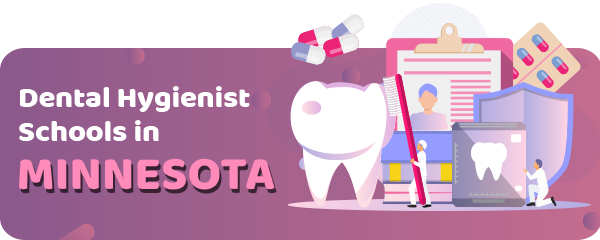In Minnesota, the demand for dental hygienists is increasing.
These professionals are overseen by the Minnesota Board of Dentistry who issues licenses to qualifying individuals.
The responsibilities of a dental hygienist include:
- Taking and developing dental x-rays
- Screening patients
- Counsel patients about nutrition and the importance of good oral health
- Removing calculus and plaque
Article Table of Contents
Training Requirements
Licenses are issued to those who completed their training.
The minimum training for a dental hygienist is 2 years of college where they can earn an Associates’s degree.
It’s very common for future dental hygienists to go for a Bachelors’s or Masters’s degree instead, as they have more employing options.
The training program has to be accredited by CODA and it contains both didactic education and practice training in a clinic.
To enroll, individuals need to hold a CPR certification which they’ll maintain over the course of their future career.
Most schools will have certain other requirements as well:
- Minimum age of 18
- Grades over C in specific classes
Some of the classes in these training programs are:
- Head and neck anatomy
- Pharmacology
- Dental radiology
- Oral pathology
- Nutrition in oral health
Those who want to administer nitrous oxide as inhalation analgesia must make sure they take the appropriate course for it, while in college.
The course has to include:
- Supervised clinical experience
- Personally administering and managing at least 3 individuals, while supervised
- At least 12 hours of didactic instruction
| School Name | Address |
|---|---|
| Argosy University | 1515 Central Parkway, Eagan, Minnesota 55121 |
| Lake Superior College | 2101 Trinity Rd, Duluth, Minnesota 55811-3399 |
| Minnesota State Community and Technical College | 1414 College Way, Fergus Falls, Minnesota 56537-1000 |
| Minnesota State University | South Rd and Ellis Ave, Mankato, Minnesota 56001 |
| Normandale Community College | 9700 France Ave S, Bloomington, Minnesota 55431-4399 |
| Rochester Community and Technical College | 851 30th Ave SE, Rochester, Minnesota 55904-4999 |
Taking the Exams
All licenses are issued after a candidate passed a series of exams.
National Board Examination
The National Board Dental Hygiene Examination (NBDHE) is organized through the Joint Commission on National Dental Examinations who need to approve the applications for the exam.
The test is computerized and has 350-multiple choice questions.
It also has a practice part in which 12 to 15 patients are being examined.
This exam takes place at the Pearson Vue testing centers.
It has to be taken with a maximum of 5 years before applying for the license.
Pass a Recognized Clinical Examination
Those who pass the NBDHE have to pass a regional clinical exam as well.
The Board in Minnesota recognizes the exams offered by the following regional agencies:
- Western Regional Examining Board (WREB)
- Central Regional Dental Testing Services (CRDTS)
The exam offered by the North East Regional Board (NERB) of Dental Examiners is accepted only it was passed between 2002 and November 30, 2009.
Pass the Jurisprudence Examination
Passing the Minnesota Jurisprudence Examination is mandatory for future dental hygienists.
The exam is administered through Prometric, Inc.
To pass for the exam is a good idea to study the following:
- The Minnesota Dental Practice Act
- The most recent CDC guidelines
Applying for the License
When all the exams are passed, candidates can fill out the application form and attach the following documents:
- Application fee – $55
- OET fee – $5.50
- Initial fee – $60
- A notarized copy of the National Board certificate or card
- A notarized copy of the regional clinical exam results
- The original or a notarized copy of the jurisprudence exam result
- A copy of the CPR certification
Along with the license application, candidates can also request the certification allowing them to administer nitrous oxide, as long as they meet the requirements.
Salary Expectations
There are several factors deciding how much a dental hygienist earns in Minnesota.
Among these factors, location and extra credentials are just a couple of them.
Annual Salary Range:| Location | Avg. Annual Salary |
|---|---|
| Minneapolis | $79,516 |
| St. Paul | $79,516 |
| Rochester | $72,413 |
| Duluth | $70,918 |
| St. Cloud | $70,529 |
| Eden Prairie | $79,382 |
| Lakeville | $79,023 |
| Burnsville | $79,292 |
| Minnetonka | $79,516 |
| Moorhead | $70,148 |
Regional Salary in Minnesota
| Region | Employed | Avg. Annual Salary | Avg. Hourly Pay | Top 10% Annual Salary | Bottom 10% Annual Salary |
|---|---|---|---|---|---|
| Duluth, MN-WI | 270 | $84,480 | $40.62 | $95,120 | $70,840 |
| Mankato, MN | 80 | $88,320 | $42.46 | $102,260 | $73,730 |
| Minneapolis-St. Paul-Bloomington, MN-WI | 3,030 | $98,760 | $47.48 | $114,400 | $80,020 |
| Rochester, MN | 220 | $92,660 | $44.55 | $103,520 | $77,510 |
| St. Cloud, MN | 230 | $90,280 | $43.40 | $100,260 | $80,510 |
* Employment conditions in your area may vary.
Maintaining the License
In Minnesota, a dental hygienist has to renew their license every 2 years.
During the renewal period, 25 continuing education credits must be completed, as follows:
- 15 fundamental dental hygiene
- 10 elective courses
2 courses must cover a different aspect of this practice:
- Infection control
- Record keeping
- Ethics
- Management of medical emergencies
- Patient communication
- Diagnosis and treatment
Read the full guide: How to Become a Dental Hygienist
